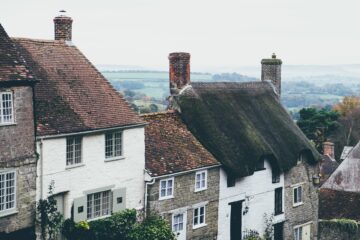If you’re considering buying a Victorian house, there’s much to consider. But don’t worry – we’re here to help. In this blog post, we’ll cover everything you need to know about Victorian houses, from their history and iconic features, to how to spot signs of wear and tear. So whether you’re a first-time buyer or a seasoned property investor, read on for all the info you need on these beautiful homes.
What is a Victorian house?
A Victorian house is a style of residence that was built during the mid to late 19th-century reign of Queen Victoria. These houses typically have unique architectural features such as an asymmetrical façade, elaborate doorways, and multi-paned windows. Victorian houses often have high ceilings with intricate detailing and decorative mouldings. Rooms are generally large and open, with decorations that are often quite fancy. Whether it’s called “Victorian,” “Edwardian,” or just a grand old house, these homes remain popular today for those who appreciate their character and charm!
The history of Victorian houses
Victorian houses have a long and fascinating history that began in the mid-19th century when the Victorian era first began. During this period, homes were much larger than their predecessors, featuring elegant and ornate architecture – some even with hundreds of rooms! The style originated in the United Kingdom and quickly spread to the United States, Canada, Australia, and New Zealand, among other countries. While many other architectural styles were popular during the era, Victorian houses remain some of the most distinct homes even today due to their dramatic eaves, turrets, bays, and details such as stained glass windows. As you can imagine, these magnificent homes took an incredible amount of labour to construct, with careful thought put into every detail. A walk through a Victorian house still retains its rightful glamour even today.
The features of a typical Victorian house
Typical Victorian houses are characterized by their ornate and intricate architectural features and spacious designs. The traditional Victorian architecture style is composed of many whimsical and decorative flourishes, including bay windows, turrets, gables, intricate brickwork and an embarrassment of chimneys. The interior also reflects the classic patterns of the era, with decorum in every room, decorative cornice mouldings around doors and windows and a central staircase as the focal point. Depending on the size of the home, these signature features were often accentuated with high ceilings to give a sense of grandeur to any space. Ultimately, this timeless style makes for a classic design that remains popular even today.
Why are Victorian houses so popular today?
Victorian houses are timeless in their beauty and remain popular today due to their historic charm. Victorian architecture offers prospective homeowners a unique blend of period features and modern amenities that can provide a more exciting dwelling than more generic housing options. The original builders of Victorian homes emphasized craftsmanship and artistry, meaning each house is individual and stylish, with detail not found in more modern designs. The use of intricate decorative elements, including wooden cornices, stained glass and gables, also offer character that draws people in from the street. Furthermore, the customizability of these properties allows homeowners to create a home that is distinctively theirs while remaining true to the era it hails from. There really is something quite special about Victorian houses that capture the imagination and makes them so desirable even today.
Why do Victorian houses have two front doors?
Victorian houses have two front doors for a variety of reasons. They provided the owner with an impressive, formal entrance to impress guests while providing convenient access to those who lived there. Inviting guests to visit through the formal door and everyday visitors or family members could use the less grand door kept closer to the kitchen area. In some cases, it was necessary to provide a separate entry door for servants or tradespeople arriving at delivery times, who could otherwise disrupt the main home activities. Beyond aesthetics and practicality, many theorize that Victorian homeowners wanted their homes to stand out from other houses on the street. The two-door setup allowed them to show off their wealth and stylish tastes.
Are Victorian Houses solid walls?
Victorian houses are often considered the epitome of beauty and elegance, but when it comes to construction, they have a unique twist. While traditional homes are built with framed walls, Victorian houses feature solid walls – made of brick, stone or sandstone blocks – that make them incredibly strong and resilient. These thick walls can help to insulate the interior while providing exceptional performance during severe weather. Additionally, other reinforcing materials like steel and concrete may be used, offering additional strength to the overall structure. It’s no wonder Victorian homes remain popular due to their sturdy construction and classic beauty!
Does anyone still build Victorian houses?
The architecture of the Victorian era is still considered one of the most beautiful styles to this day. While fewer people are choosing to build a completely traditional Victorian house today, many modern homes incorporate aspects of it in their design. For example, Craftsman-style houses often feature steep roofs that emulate the look of a traditional house from that period. Still, others use Victorian-style decorations for accents and ornamental flourishes. In addition, many houses in older neighbourhoods still maintain much of their original exterior construction style from when they were first built. Although many people choose something different for new construction, the iconic beauty of Victorian architecture continues to attract admirers everywhere.
Are Victorian Houses cold?
Though it may seem logical to assume that Victorian houses are cold and uncomfortable due to their age, the truth is quite different. Many Victorian houses have been masterfully constructed and contain excellent insulation that can hold heat in for much longer than more recently built homes. In fact, many of these vintage homes contain some of the most modern heating systems available to help keep them comfortable when the air outside starts to chill. Therefore, living in a Victorian home does not have to be synonymous with freezing temperatures.
Are Victorian Houses worth buying?
Buying a Victorian house can be a great investment if you know the potential for costly repairs and renovations. Although these houses are often expensive, with their high price tags come extra touches that give them their unique charm. Things like bay windows, floor-to-ceiling windows, intricate woodworking, fireplaces and original fixtures add character to a Victorian home that is difficult to replicate in newly built houses. After all the restoration work is completed, a Victorian house will typically gain value and appeal – making it well worth the effort for proud new owners.
How do you stop dampness in Victorian houses?
Victorian houses are unique and beautiful, but they can also have challenges. One of the most common problems is dampness. It might start with a musty smell or mildew in one room, but it will eventually spread if left untreated. The best way to stop it is by tackling the root cause: moisture. Start by identifying any sources of water ingress, such as roof leaks and ensure they’re appropriately fixed. Additionally, checking your ventilation systems regularly to ensure airflow is adequate is essential for keeping dampness away; this includes ensuring your bathroom fans are working correctly and adding an extractor fan near cooking areas if necessary. Lastly, installing dehumidifiers in rooms where moisture tends to linger can help create an inhospitable environment to damp spores. Implementing these steps should help you keep dampness at bay so you can enjoy a healthy home without fear of mould ruining your beautiful Victorian house!
Why do Victorian Houses have high ceilings?
Victorian houses have high ceilings for several reasons. One of the most popular reasons is to create an airy and open atmosphere. As this era of housing was about creating luxury, the spacious ceilings provided the aesthetic many homeowners desired. Additionally, higher ceilings allowed more light into the rooms, making them much brighter during daylight hours. Even as natural lighting during this period was scarce, Victorian homes still appeared bright and luxurious due to their taller ceilings. In addition to providing aesthetic appeal, higher ceilings also allowed for easier ventilation, given the lack of modern air conditioning. Finally, some may speculate that at least part of the motivation behind creating tall ceilings was to show off wealth or status – a showroom effect.
How deep are foundations in Victorian houses?
With their distinctive style and opulent appearance, Victorian houses tend to have an impressive foundation. People are usually surprised at the depth of these foundations – and rightly so. The depth of a typical Victorian house’s foundation is usually around six feet or more below the ground surface. This foundation is designed to be strong enough to support the structure above it and any load placed on it over time, such as soil movements or additional construction above ground. The higher the mass and size of the home, the deeper the foundation needs to be to ensure a solid base for years to come. While they may not share other common features of modern homes, one undeniable feature of Victorian houses is their deep and durable foundations.
Do Victorian homes have cavity walls?
While many traditional building techniques are used in Victorian-style homes, it is uncertain whether or not cavity walls were one of them. Cavity walls became popular in the early to mid-20th century as they improved insulation and helped to reduce moisture penetration into homes. It is possible that some Victorian-era builders may have adopted these techniques, but it would have been more likely for them to use solid stone and brickwork construction methods instead. Therefore, whether or not a particular Victorian home features cavity walls primarily depends on the builders themselves.
How to renovate or decorate a Victorian house?
One of the most rewarding experiences for a homeowner is renovating or decorating a Victorian house. Carefully chosen furniture, fixtures, and colours can transform even the most outdated home into a cosy yet timeless space. Start by focusing on your flooring – the parquet can ideally reflect the original period charm while still offering practical durability. Invest in quality pieces that are sure to impart an elegant touch, such as ornate sofas and writing tables with elaborately carved details. An antique-inspired chandelier can also accentuate the décor of your Victorian abode. These design tips will help you create a unique home that is a beautiful reminder of days gone by.
What to look out for when buying a Victorian house?
When looking for a Victorian house, it is important to consider not just the property’s aesthetic appeal but also the potential problems associated with owning one. Look out for water damage and excess moisture, as these can be difficult and expensive to fix. Ensure wiring is up to code and check for any signs of foundation defects or structural problems such as sinking floors, uneven floors, bowing walls, etc. Be wary of houses built before 1920 that still contain lead paint or asbestos insulation. Finally, look at the roof and see if it might need repair – many Victorian homes require costly roofing maintenance that you should factor into your budget.
Conclusion
Though they were favoured over 100 years ago, Victorian houses are still admired and sought-after. These homes are easily identified by their intricate designs and beautiful decorations. If you’re lucky enough to own a Victorian home, you can renovate it to bring back its original splendour or decorate it in a way that suits your style. No matter what you do with your Victorian house, it’s sure to be a stunning place to call home.


